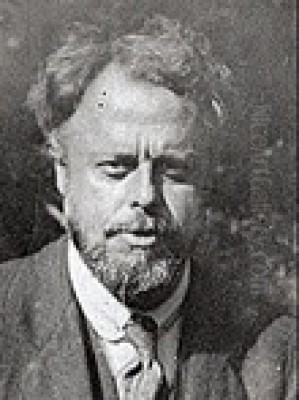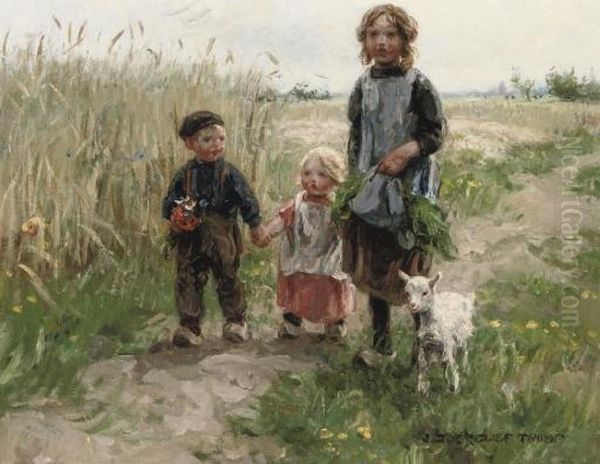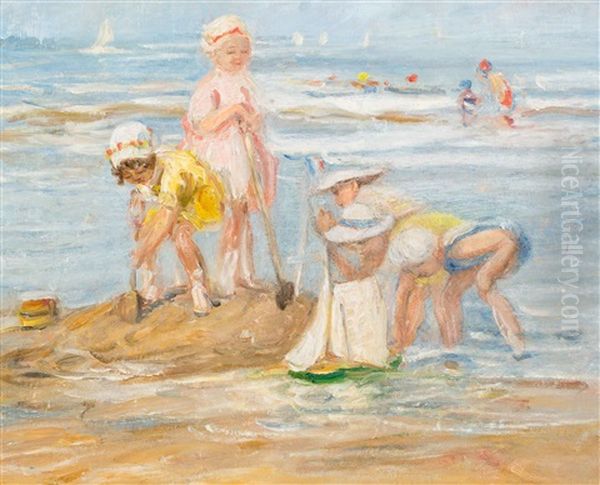
Jan Zoetelief Tromp stands as a cherished figure in Dutch art history, renowned for his heartwarming depictions of childhood, rural life, and the sun-drenched landscapes of the Netherlands. Born into a world undergoing significant artistic shifts, Tromp carved a niche for himself with his optimistic and brightly lit canvases, distinguishing his work within the lineage of the Hague School yet imbuing it with a personal, tender touch. His life, marked by early adversity, and his art, celebrated for its gentle charm, offer a compelling narrative of resilience and dedication to capturing the fleeting beauty of everyday moments.
Birth in the Dutch East Indies and Early Challenges
Johannes Zoetelief Tromp, who would become known to the art world as Jan Zoetelief Tromp, was born on December 3, 1872, in Batavia, the capital of the Dutch East Indies, now Jakarta, Indonesia. His father, Jan Wallez Tromp, was a civil servant in the colonial administration, a position that placed the family within the expatriate Dutch community far from the artistic centers of Europe. This distant birthplace provided a unique, albeit brief, backdrop to his earliest years, a world of tropical light and different cultural rhythms that he would leave behind in his formative childhood.
A significant challenge emerged early in Tromp's life: he became deaf as a young child. This profound sensory alteration could have easily isolated him, but his family, particularly his grandmother, Maria Geertruida Tromp (née Zoetelief), recognized the need for specialized support and education. Understanding the limitations of facilities in the Dutch East Indies for a child with his condition, she made the pivotal decision to bring young Jan back to the Netherlands. This move was not merely for a change of scenery but was a dedicated effort to provide him with the best possible opportunities for development and learning, a testament to familial devotion that would shape his future. In the Netherlands, he would receive an education tailored to his needs, including time at a school for the deaf in Rotterdam, which equipped him with tools to navigate and communicate in a hearing world.
Artistic Education and Formative Influences

The Netherlands, with its rich artistic heritage, proved to be fertile ground for Tromp's burgeoning talent. His formal artistic training commenced at the prestigious Royal Academy of Art in The Hague (Koninklijke Academie van Beeldende Kunsten). This institution had a long history of nurturing Dutch artists and provided him with a solid foundation in drawing and painting techniques. Here, he would have been exposed to the prevailing artistic currents, particularly the lingering influence of the Hague School, which emphasized realistic depictions of Dutch landscape and peasant life, often with a somber, atmospheric palette.
Following his studies in The Hague, Tromp further honed his skills at the Rijksakademie van Beeldende Kunsten (State Academy of Fine Arts) in Amsterdam. This was a significant step, as the Rijksakademie was a leading center for art education in the country. During his time there, he came under the tutelage of August Allebé, a respected painter and the academy's director. Allebé was known for his genre scenes and portraits and was an influential teacher to a generation of Dutch artists, including figures like Jan Veth, Isaac Israëls, and George Hendrik Breitner, who would later become prominent Amsterdam Impressionists. Allebé's guidance would have been instrumental in refining Tromp's technique and encouraging his artistic voice, even as Tromp began to gravitate towards a brighter, more optimistic style than some of his contemporaries.
The Hague School and Impressionistic Light
Jan Zoetelief Tromp's artistic development occurred during a period when the Hague School was a dominant force in Dutch painting. This movement, which flourished roughly between 1860 and 1890, drew inspiration from the French Barbizon School, emphasizing plein air painting and realistic depictions of the Dutch landscape, peasant life, and fishing communities. Key figures of the Hague School included Jozef Israëls, known for his poignant scenes of fisherfolk; Anton Mauve, celebrated for his landscapes with sheep; Hendrik Willem Mesdag, famous for his seascapes; and the Maris brothers—Jacob, Matthijs, and Willem—each contributing uniquely to the school's ethos with their atmospheric and often melancholic portrayals of Dutch life. Other notable members included Johannes Bosboom, a master of church interiors, Willem Roelofs, and Paul Gabriël, who captured the polder landscapes with great sensitivity.

While Tromp's subject matter—rural scenes, simple folk, and children—aligned with the thematic concerns of the Hague School, his stylistic approach began to diverge, particularly in his use of color and light. The earlier phase of the Hague School was often characterized by a more subdued, tonal palette, sometimes referred to as the "Grey School" due to its emphasis on atmosphere and muted colors. However, as French Impressionism gained traction, its influence began to permeate Dutch art. Artists started experimenting with brighter colors, broken brushwork, and a greater emphasis on capturing the fleeting effects of light and atmosphere.
Tromp embraced this shift towards a lighter, more vibrant palette. His paintings are often suffused with sunlight, casting a cheerful glow over his subjects. This departure from the more somber tones of some Hague School masters set his work apart and contributed to its popular appeal. He skillfully captured the play of light on figures and landscapes, creating scenes that felt fresh, airy, and optimistic. This affinity for light and color shows a clear, if perhaps indirect, nod to the innovations of French Impressionists like Claude Monet, Pierre-Auguste Renoir, and Camille Pissarro, whose work was becoming increasingly known and appreciated across Europe.
A Lifelong Mentor: Bernardus Blommers
A pivotal figure in Jan Zoetelief Tromp's personal and artistic life was Bernardus Johannes Blommers (1845-1914). Blommers was an established and respected member of the Hague School, particularly known for his charming and sentimental depictions of peasant mothers and children, often set in the interiors of fishermen's cottages or on the beaches of Scheveningen. Tromp not only became a student and protégé of Blommers but also developed a close personal bond with him, eventually marrying Blommers' daughter, Maria Johanna Blommers.
This familial connection undoubtedly deepened their artistic relationship. Blommers' influence on Tromp is evident in the younger artist's choice of subject matter, particularly his focus on children and scenes of simple, domestic life. Like Blommers, Tromp approached these subjects with warmth and empathy, avoiding overt social commentary in favor of celebrating the innocence and joy of childhood. However, Tromp often infused his scenes with even more sunlight and a brighter palette than his father-in-law, developing his own distinct, sunnier interpretation of similar themes. Blommers' guidance and support would have been invaluable, providing Tromp with both technical instruction and an entry into the established art circles of The Hague.
The Enduring Theme of Childhood
The most defining characteristic of Jan Zoetelief Tromp's oeuvre is his tender and joyful portrayal of children. His canvases are populated with rosy-cheeked youngsters engaged in simple pleasures: playing on the beach, walking through sunlit meadows, tending to animals, or gathered in domestic settings. These scenes are imbued with a sense of nostalgia and an idealized vision of childhood innocence, free from the hardships and complexities of adult life.
Works such as "Spelende kinderen op het strand van Katwijk" (Children Playing on the Beach at Katwijk) exemplify this focus. Here, children are depicted engrossed in their play, their small figures animated against the backdrop of the sea and sand, bathed in a warm, inviting light. Similarly, "Children walking through a meadow" captures a moment of carefree exploration, the figures almost blending into the vibrant, sun-dappled landscape. These paintings resonate with a universal appeal, evoking a sense of warmth and happiness.
Tromp's fascination with childhood was not unique in an era that often romanticized youth, but his consistent dedication to the theme and the sheer delight conveyed in his paintings made him a master of this genre. His own experience with deafness from a young age may have contributed to a heightened visual sensitivity and a particular empathy for the world of children, a world often lived more through immediate sensory experience than complex verbal communication. His paintings seem to celebrate the uninhibited joy and simple wonders that characterize childhood.
Notable Works and Artistic Style
Beyond his general themes, several specific works highlight Tromp's artistic style and preoccupations. "The Garden Swing" is a quintessential Tromp painting, capturing a moment of playful exuberance. The movement of the swing, the laughter of the children, and the dappled sunlight filtering through leaves would all be rendered with his characteristic bright palette and lively brushwork, creating an image of idyllic charm.
"Returning with the Catch" likely depicts a scene from a fishing village, perhaps showing children accompanying fishermen or playing with the day's haul. Such paintings connect to the Hague School's interest in the lives of coastal communities but are filtered through Tromp's optimistic lens, focusing on the picturesque and heartwarming aspects rather than the toil and hardship often portrayed by artists like Jozef Israëls.
His style is characterized by a relatively smooth application of paint, though with enough texture to convey a sense of vibrancy. His figures, while idealized, are rendered with care and anatomical understanding. The compositions are typically well-balanced, drawing the viewer's eye to the central figures and their activities. But it is his mastery of light that truly defines his work. Sunlight is almost a tangible presence in his paintings, illuminating scenes with a cheerful radiance and creating a sense of warmth and well-being. This consistent use of bright, clear light and optimistic subject matter made his work highly popular, especially in the post-war period in the Netherlands, when there was a yearning for images of peace and simple happiness.
The Katwijk Connection and Artistic Community
Like many artists of his time, Jan Zoetelief Tromp was drawn to artists' colonies, places where painters could find affordable lodging, picturesque scenery, and the camaraderie of fellow creatives. He spent considerable time in Katwijk aan Zee, a fishing village on the North Sea coast that became a popular destination for artists, particularly those associated with the Hague School and later movements. The dunes, beaches, and the traditional life of the fishing community provided ample inspiration.
In Katwijk, Tromp would have been part of a vibrant artistic milieu. He is known to have associated with Jan Toorop (1858-1928), a highly versatile and influential Dutch-Indonesian artist who explored various styles, from Impressionism and Pointillism to Symbolism and Art Nouveau. While Toorop's artistic trajectory was perhaps more experimental and varied than Tromp's, their time in Katwijk would have provided opportunities for interaction and exchange of ideas. Other artists who frequented Katwijk included the German Impressionist Max Liebermann, who was captivated by the Dutch coastal scenes. The presence of such diverse talents would have enriched the artistic environment, even for an artist like Tromp who maintained a consistent stylistic focus.
Interactions with Other Contemporaries
While Bernardus Blommers was his primary mentor, Tromp operated within a broader Dutch art world. His teacher, August Allebé, connected him to a generation of artists who passed through the Rijksakademie. Though their styles often diverged, figures like Isaac Israëls and George Hendrik Breitner, leading proponents of Amsterdam Impressionism, were his contemporaries. Their focus was more urban, capturing the bustling city life of Amsterdam with a dynamic, sketch-like technique, contrasting with Tromp's idyllic rural and coastal scenes.
The legacy of earlier Hague School painters like Anton Mauve, with his gentle depictions of sheep and rural landscapes, or Willem Maris, known for his sunlit paintings of cattle near water, provided a foundation upon which Tromp built. While he shared their love for the Dutch countryside, his interpretation was consistently brighter and more focused on the joyful aspects of life. His work also stands in contrast to the more Symbolist or modern art explorations of contemporaries like Piet Mondrian (in his early, pre-abstract phases) or Bart van der Leck, who were pushing Dutch art in entirely different directions. Tromp remained committed to a more traditional, albeit brightly rendered, form of realism.
Overcoming Adversity and Personal Life
Jan Zoetelief Tromp's deafness was a significant factor in his life, but it did not impede his artistic career. Indeed, some might argue that it sharpened his visual perception, making him an even keener observer of the world around him. His ability to succeed as a professional artist despite this challenge is a testament to his determination and talent, as well as the support he received from his family and mentors. His recognition as a notable deaf historical figure underscores this achievement.
His marriage to Maria Johanna Blommers, the daughter of his mentor, was a central aspect of his personal life. This union not only solidified his connection to the Blommers family and the Hague School tradition but also likely provided a stable and supportive home environment conducive to his artistic pursuits. His own children often served as models for his paintings, lending an authentic and personal touch to his depictions of childhood. The name "Zoetelief," which he incorporated into his professional name (from his grandmother's maiden name), fittingly translates to "sweet love" or "sweet dear," an apt reflection of the gentle and affectionate nature of his art.
Exhibitions, Recognition, and Lasting Legacy
Jan Zoetelief Tromp's work gained considerable popularity during his lifetime and beyond. His paintings were regularly exhibited in the Netherlands and also found an appreciative audience internationally, with showings in the United Kingdom and the United States. This international exposure helped to solidify his reputation as a skilled painter of charming and accessible scenes.
His works were acquired by various museums, including institutions in Amsterdam and The Hague, ensuring their preservation and continued visibility. Today, his paintings remain highly sought after by private collectors, and they frequently appear at auction, attesting to their enduring appeal. The consistent demand for his art speaks to its timeless quality and the universal resonance of his chosen themes.
Tromp passed away on September 28, 1947, in Breteuil, France, where he had moved later in life. He left behind a significant body of work that continues to delight viewers with its optimism and technical finesse. His legacy is that of an artist who, while rooted in the traditions of Dutch realism, infused his work with a distinctive brightness and a profound appreciation for the simple joys of life, particularly the innocent world of children. He remains a beloved figure, a painter whose canvases offer a sunny escape and a reminder of the enduring beauty to be found in everyday moments.
In conclusion, Jan Zoetelief Tromp was more than just a painter of pretty pictures. He was an artist who, despite personal challenges, developed a distinctive and uplifting style. Drawing from the rich heritage of the Hague School and touched by the brighter palette of Impressionism, he created a world on canvas that celebrated light, life, and the unblemished joy of youth. His interactions with key figures like Bernardus Blommers and his place within the artistic communities of The Hague and Katwijk situate him firmly within the narrative of late 19th and early 20th-century Dutch art. His enduring popularity is a testament to his skill in capturing a sense of warmth and happiness that continues to resonate with audiences today.